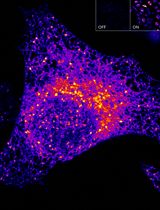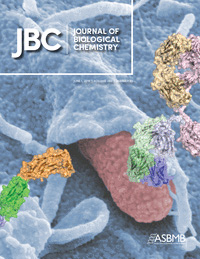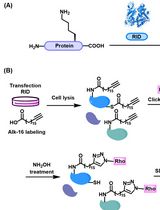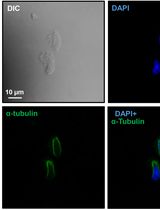- EN - English
- CN - 中文
Cell-free Reconstitution of the Packaging of Cargo Proteins into Vesicles at the trans Golgi Network
反面高尔基体网状结构中货物蛋白包装成囊泡的无细胞重组
(*contributed equally to this work) 发布: 2020年03月05日第10卷第5期 DOI: 10.21769/BioProtoc.3537 浏览次数: 5067
评审: Ralph Thomas BoettcherAnonymous reviewer(s)

相关实验方案

高灵敏且可调控的 ATOM 荧光生物传感器:用于检测细胞中蛋白质靶点的亚细胞定位
Harsimranjit Sekhon [...] Stewart N. Loh
2025年03月20日 2160 阅读
Abstract
Protein sorting at the trans Golgi network (TGN) plays important roles in targeting newly synthesized proteins to their specific destinations. The aim of this proposal is to reconstitute the packaging of non-Golgi resident cargo proteins into vesicles at the TGN, utilizing rat liver cytosol, semi-intact mammalian cells and nucleotides. The protocol describes how to perform the vesicle formation assay, how to isolate vesicles and how to detect cargo proteins in vesicles. This reconstitution assay can be used to quantitatively measure the efficiency of the packaging of a specific cargo protein into transport vesicles at the TGN under specific experimental conditions.
Keywords: TGN (反面高尔基体网状结构)Background
The trans Golgi network (TGN) is an essential transport hub in the secretory transport pathway. To ensure the fidelity of vesicular trafficking, eukaryotic cells employ a variety of protein sorting machineries to accurately package specific cargo proteins into transport vesicles at the TGN which are then delivered to specific destinations (Guo et al., 2014). To deepen our understanding of the specificity of the TGN sorting process, it is important to develop an assay that can faithfully reconstitute the vesicle formation and cargo sorting process at the TGN. This assay can be utilized to directly and quantitatively measure the roles of a specific factor in regulating the packaging of a specific cargo protein into transport vesicles. Cell-free reconstitution of the packaging of cargo proteins into COPII vesicles from the endoplasmic reticulum (ER) has been well established (Kim et al., 2005; Kim et al., 2007; Merte et al., 2010; Yuan et al., 2018; Niu et al., 2019;). An in vitro assay that reconstitutes the release of a specific cargo protein, TGN46, into transport vesicles at the TGN has been developed (Ponnambalam et al., 1996; Wakana et al., 2012). TGN46 is mainly localized at the TGN, although it can cycle between the TGN and the plasma membrane (Ponnambalam et al., 1996). Recently, we devised an alternative vesicle budding protocol to reconstitute the packaging of non-Golgi resident cargo proteins into vesicles at the TGN (Ma et al., 2018). We performed the vesicle formation assay by incubating cells at 20 °C to accumulate newly synthesized cargo proteins at the TGN and performed the budding reaction in the presence of the GTPase defective mutant, Sar1A(H79G), to inhibit packaging of cargo proteins into Coat Protein Complex II (COPII) vesicles at the ER. Moreover, we utilized floatation to efficiently remove cytosolic proteins that are not associated with vesicles (Figure 1). Using this assay, we have reconstituted release of planar cell polarity proteins, Vangl2 and Frizzled6, from the TGN (Ma et al., 2018). Our assay indicates that the tyrosine sorting motif on Vangl2 and the polybasic sorting motif on Frizzled6 are important for packaging into vesicles (Ma et al., 2018). The GTPase defective mutant form of Arfrp1, Arfrp1 (Q79L), can inhibit the packaging of Vangl2 in vesicles in a concentration dependent manner (Ma et al., 2018).
Materials and Reagents
- Razor blade
- 10 cm cell and tissue culture dishes (Biofil, catalog number: TCD-010100 )
- 15 ml centrifuge tubes (Biofil, catalog number: CFT-011150 )
- Falcon® 50 ml centrifuge tubes (Corning, catalog number: 352070 )
- 1,000 μl tips (USA Scientific, catalog number: 11112021 )
- 200 μl tips (Axygen, catalog number: T200-Y )
- 0.5-10 μl tips (Axygen, catalog number: T300 )
- 1.5 ml microtubes (Axygen, catalog number: 20220415 )
- Axygen® 1.5 ml Maxymum recovery® microcentrifuge tube (low retention) (Corning, Axygen®, catalog number: MCT-150-L-C )
- Polypropylene copolymer ultracentrifuge tube (2.2 ml capacity volume, Hitachi Koki S300536A)
- Polycarbonate tubes, 0.5 ml capacity volume (Beckman Coulter, catalog number: 343776 )
- 200 μl gel loading tips (Thermo Fisher Scientific, catalog number: 010-Q )
- Paragon® Disposable Sterile Blades (Medicom, catalog number: 90010-10 )
- BemisTM ParafilmTM M Laboratory Wrapping Film (Thermo Fisher Scientific, catalog number: 13-374-12 )
- Immobilon®-P transfer membrane PVDF 0.45 μm (Merck, catalog number: IPVH00010 )
- Corning 1 L filter system 0.22 μm (Corning, catalog number: 431098 )
- Sprague-Dawley rats
- Dulbecco's Modified Eagle Medium (DMEM) (Thermo Fisher Scientific, catalog number: 12800082 )
- Opti-MEM (Gibco, catalog number: 31985070 )
- Sodium bicarbonate (Sigma-Aldrich, catalog number: S5761 )
- Fetal bovine serum (FBS) (Thermo Fisher Scientific, catalog number: 10270106 )
- Penicillin streptomycin (Thermo Fisher Scientific, catalog number: 15140122 )
- Polyethylenimine (Polysciences, catalog number: 23966-1 )
- Bio-Rad protein assay dye reagent concentrate (Bio-Rad Laboratories, catalog number: 5000006 )
- Liquid nitrogen
- 0.25% trypsin-EDTA (Thermo Fisher Scientific, catalog number: 25200056 )
- OptiPrepTM density gradient medium (Sigma-Aldrich, catalog number: D1556 )
- Brilliant blue R (Sigma-Aldrich, catalog number: B0149 )
- 2-Mercaptoethanol (βME) (Sigma-Aldrich, catalog number: M6250 )
- 3-color regular range protein marker (Genefist, catalog number: GF6616 )
- Blotting-Grade Blocker (Bio-Rad Laboratories, catalog number: 1706404 )
- Sodium azide (NaN3) (Sigma-Aldrich, catalog number: S8032 )
- SuperSignalTM west pico PLUS chemiluminescent substrate (Thermo Fisher Scientific, catalog number: 34580 )
- HEPES (Acros Organics, catalog number: 172571000 )
- Potassium chloride (KCl) (VWR Chemicals BDH®, catalog number: 2576 )
- Acetic acid, potassium salt (KOAc) (Fisher Scientific, catalog number: 127082 )
- Magnesium acetate tetrahydrate (Mg(OAc)2) (Sigma-Aldrich, catalog number: M0631 )
- D-Sorbitol (Sigma-Aldrich, catalog number: S1876 )
- Sodium dodecyl sulfate (SDS) (Sigma-Aldrich, catalog number: 151213 )
- Bromophenol blue
- Tris (Affymetrix, catalog number: 75825 )
- Glycine
- 40% Acrylamide/Bis Solution (Bio-Rad Laboratories, catalog number: 1610148 )
- Ammonium persulfate (APS) (Sigma-Aldrich, catalog number: A3678 )
- N,N,N′,N′-Tetramethylethylenediamine (Sigma-Aldrich, catalog number: T7024 )
- Sodium dihydrogen phosphate dihydrate (NaH2PO4·2H2O) (VWR Chemicals BDH®, catalog number: 1514L )
- Potassium phosphate dibasic (K2HPO4) (Sigma-Aldrich, catalog number: P3786 )
- Sodium chloride (NaCl) (Sigma-Aldrich, catalog number: S5886 )
- Glycerol (Sigma-Aldrich, catalog number: G7757 )
- Triton® X-100 (Sigma-Aldrich, catalog number: X100 )
- Tween® 20 (Sigma-Aldrich, catalog number: P1379 )
- Protease inhibitor cocktail tablets (Roche, catalog number: 0 5056489001 )
- DL-dithiothreitol (Sigma-Aldrich, catalog number: D9779 )
- Digitonin (Sigma-Aldrich, catalog number: D141 )
- Dimethyl sulfoxide (DMSO) (Sigma-Aldrich, catalog number: D8418 )
- Creatine phosphate (Roche, catalog number: 10621722001 )
- Creatine kinase (Roche, catalog number: 10736988001 )
- Adenosine 5'-triphosphate (ATP) (Sigma-Aldrich, catalog number: 2383 )
- Guanosine 5'-Triphosphate Disodium Salt (GTP) (FUJIFILM Wako Pure, catalog number: 073-03113 )
- Methanol (Scharlab, catalog number: 0 949 )
- Trypsin inhibitor from glycine max (soybean) (Sigma-Aldrich, catalog number: T9003 )
- HyClone® trypan blue solution (GE Healthcare, HyCloneTM, catalog number: SV30084 )
- Antibodies
- Rabbit anti SEC22B was a gift from Prof. Randy Schekman (University of California, Berkeley, CA, USA), and it was used at 1:2,000
- Sheep anti TGN46 (Bio-Rad Laboratories, catalog number: AHP500G ), and it was used at 1:2,000
- Rabbit anti HA (Cell signaling technology, catalog number: 3724 ), and it was used at 1:2,000
- Horseradish peroxidase (HRP)-coupled sheep antibodies against rabbit IgG (GE Healthcare, catalog number: NA934 ), and it was used at 1:5,000
- Anti-sheep IgG–Peroxidase antibody (Sigma-Aldrich, catalog number: A3415 ), and it was used at 1:5,000
- Buffer solutions (see Recipes)
- KHM buffer (1×)
- KHM buffer (2×)
- KHM buffer (10×)
- SDS-PAGE protein loading buffer (5×)
- Transfer buffer
- SDS-PAGE running buffer
- 5% blotting-grade blocker
- PBS
- PBST
- Buffer E
- Lysis buffer
- Stock solutions (see Recipes)
- 10× PBS, pH 7.4
- SDS-PAGE running buffer (10×)
- 1 M KOAc
- 1 M HEPES-KOH, pH 7.2
- 1 M Mg(OAc)2
- 1.5 M Tris-HCl, pH 8.8
- 1 M Tris-HCl, pH 6.8
- 10% SDS
- 10% APS
- 3% NaN3
- 40 mg/ml digitonin
- 100x Protease inhibitors
- 500 mM DTT
- ATP regeneration system (ATP r.s.)
- 10 mM GTP
- 1 mg/ml polyethylenimine
Equipment
- Small beaker
- Dissection scissors
- -80 °C freezer
- Drill (Craftsman 3/8 inch professional electric drill) (Craftsman, model: 315.26946 0 or equivalent)
- Dounce homogenizer (Kimble® 886000-0024 Kontes® 45 ml Potter-Elvehjem Tissue Grinder with PTFE Pestle and Unground Glass Tube, Size: 24, Manufacturer Part No: KIM-886000-0024)
- Eppendorf® 5418R centrifuge, refrigerated, with rotor FA-45-18-11 and rotor lid (Eppendorf®, model: 5418R , catalog number: 5401000013)
- Beckman Coulter high speed centrifuge, with rotor JA-25.50 and rotor lid (Beckman Coulter, model: Avanti® J-E, catalog number: 369001)
- Hitachi ultracentrifuge with T-865 rotor and rotor lid (Hitachi, catalog number: S99978101 )
- Light microscope with a 10× or 20× objective (any simple or compound light microscope is fine)
- Hitachi Koki himac CS150NX micro ultracentrifuge with S55S-2080 rotor, S120A3-2061 rotor and rotor lids (Hitachi, catalog number: HK-CS150NX )
- Barnstead Thermolyne (Thermo Fisher, model: DB16520-26 catalog number: 05852)
- Elite dry bath incubator (Major Science, model: EL-02 catalog number: 95070)
- Eppendorf® 5804R centrifuge with rotor A-4-44 (Eppendorf®, model: 5804R , catalog number: 5805000327)
- Cell disruptor (Disruptor Genie®, catalog number: SI-D268 )
- ChemiDocTM MP Imaging System (Bio-Rad Laboratories, model: ChemiDocTM MP)
Software
- ImageLab software v4.0
- ImageJ
Procedure
文章信息
版权信息
© 2020 The Authors; exclusive licensee Bio-protocol LLC.
如何引用
Readers should cite both the Bio-protocol article and the original research article where this protocol was used:
- Tang, X., Yang, F. and Guo, Y. (2020). Cell-free Reconstitution of the Packaging of Cargo Proteins into Vesicles at the trans Golgi Network. Bio-protocol 10(5): e3537. DOI: 10.21769/BioProtoc.3537.
- Ma, T., Li, B., Wang, R., Lau, P. K., Huang, Y., Jiang, L., Schekman, R. and Guo, Y. (2018). A mechanism for differential sorting of the planar cell polarity proteins Frizzled6 and Vangl2 at the trans-Golgi network. J Biol Chem 293(22): 8410-8427.
分类
分子生物学 > 蛋白质 > 检测
生物化学 > 蛋白质 > 翻译后修饰
细胞生物学 > 细胞器分离 > 高尔基体
您对这篇实验方法有问题吗?
在此处发布您的问题,我们将邀请本文作者来回答。同时,我们会将您的问题发布到Bio-protocol Exchange,以便寻求社区成员的帮助。
Share
Bluesky
X
Copy link











